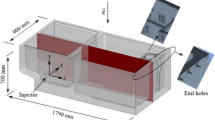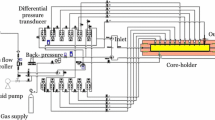The workflow of a bladder tank foam mixer is investigated. A physical and mathematical model of the workflow based on the Bernoulli and continuity equations with the use of empirical dependences of the hydraulic resistance and discharge coefficients on the Reynolds number is proposed. The resulting model allows determining the diameters of the dosing diaphragms in the first approximation. A numerical simulation of the workflow of a bladder tank foam mixer has been carried out in ANSYS CFX. A method for calculating the diameters of dosing diaphragms based on the physical and mathematical model and numerical simulation of the workflow using the method of successive approximation has been developed. An example of calculating the diaphragms of a foam mixer for a given range of water flow rate, foam concentration and diameters of the pipes supplying water and foam concentrate is given.






Similar content being viewed by others
References
V. B. Bodnaruk and I. M. Vertyachikh, “Analysis of foam concentrate dosing systems for modern fire pumps (review),” Chrezvych. Sit. Obraz. Nauka, 7, No. 1, 3–16 (2012).
V. V. Terebnev, N. I. Ulyanov, and V. A. Grachev, Firefighting Equipment. Configuration and Application [in Russian], Tsentr Propagandy, Moscow (2007).
J. L. Scheffey, “Foam agents and AFFF system design considerations,” in: SFPE Handbook of Fire Protection Engineering, Springer, New York (2016).
I. E. Idel’chik, Handbook of Hydraulic Resistance [in Russian], Mashinostroenie, Moscow (1992).
A. D. Girgidov, Mechanics of Liquid and Gas (Hydraulics): Textbook for Universities [in Russian], Izd-vo Politekhnicheskogo Universiteta, St. Petersburg (2007).
T. M. Bashta, S. S. Rudnev, B. B. Nekrasov, et al., Hydraulics, Hydraulic Machines and Hydraulic Drives [in Russian], Mashinostroenie, Moscow (1982).
A. D. Al’tshul’, L. S. Zhivotovsky, and L. P. Ivanov, Hydraulics and Aerodynamics: Textbook for Universities [in Russian], Stroiizdat, Moscow (1987).
Author information
Authors and Affiliations
Corresponding author
Additional information
Translated from Khimicheskoe i Neftegazovoe Mashinostroenie, Vol. 57, No. 7, pp. 40−44, July, 2021.
Rights and permissions
About this article
Cite this article
Khabarova, D.F., Lazarev, I.I. & Bityutskikh, K.V. Model of the Workflow of a Bladder Tank Diaphragm Foam Mixer and a Method for Calculating the Two Diaphragm Diameters. Chem Petrol Eng 57, 601–610 (2021). https://doi.org/10.1007/s10556-021-00982-1
Published:
Issue Date:
DOI: https://doi.org/10.1007/s10556-021-00982-1




